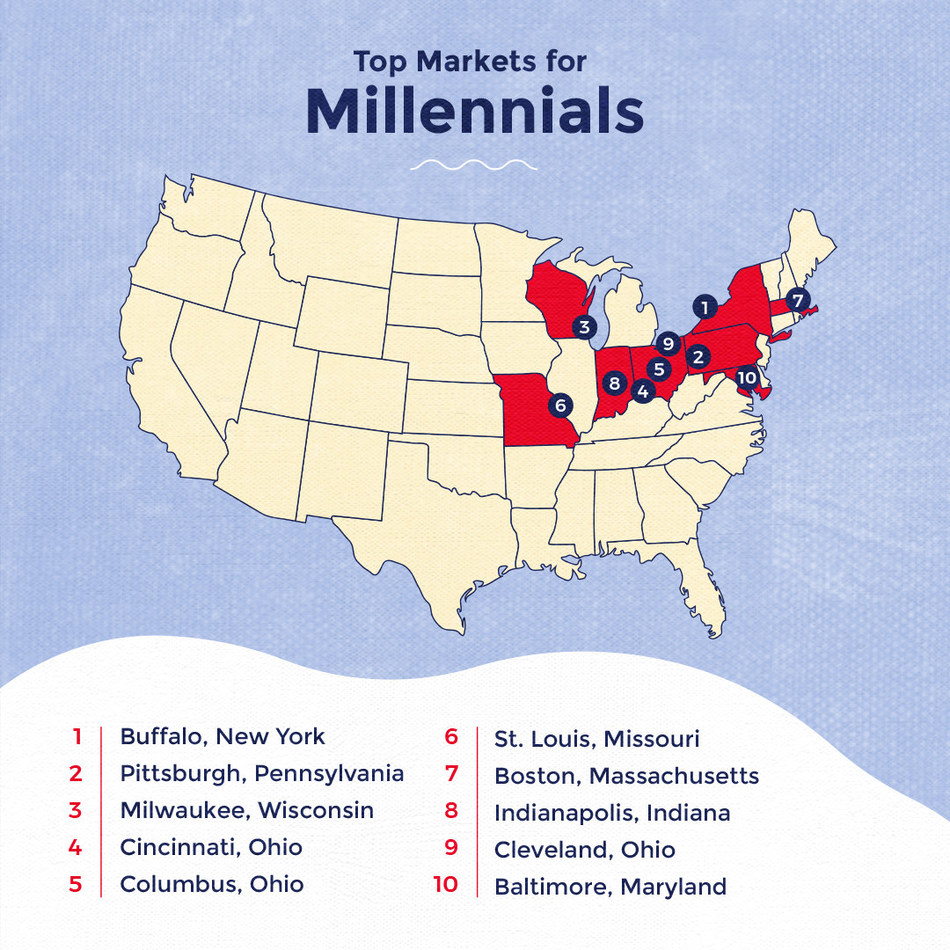OTHER NEWS
The Learning Center
Our Learning Center ensures that every reader has a resource that helps them establish and maintain a competitive advantage, or leadership position. For instance, loan originators and brokers will have one-click access to resources that will help them increase their productivity. Search topics by category and keyword and generate free videos, webinars, white papers and other resources. If you would like to add your content to the learning center, please click here or email Tim Murphy at [email protected].
Rise of Millennial Home Buyers
- Wednesday, 20 February 2019
- Originating

The millennial generation have increased their home buying purchase power and now boast the largest share of new home loans by dollar volume, larger than Generation X and the baby boomer generation.
Millennials are showing interest in more affordable markets. Additionally, millennials are making lower down payments and taking on larger mortgages when compared to Gen Xers and baby boomers, according to a realtor.com analysis of residential mortgage loan originations from Optimal Blue.
"Millennials are getting older, with better jobs and deeper pockets, allowing them to expand their collective purchase power, and hence, their footprint in the market," said Javier Vivas, director of economic research at realtor.com. "The stereotype that millennials choose to buy homes and live in large metro areas isn't the reality. Results show millennials' expansion is more heavily conditioned by affordability than in prior years, so their eyes are set on less traditional secondary markets where homes and jobs are now available and plentiful."
[adbutler zone_id="326324"]
[adbutler zone_id="326327"]
Affordability is such a key factor for millennial home buyers that this generation is moving to places previous generations have not, like Buffalo, N.Y., the top affordable market for millennials.
Millennials are still primarily in the life stage that requires starter homes. Despite a lower median purchase price ($238,000) than the two generations before them, (with baby boomers and Gen Xers spending an average of $264,000and $289,000, respectively), millennials are increasing their purchase price at a faster rate than previous generations, indicative of this generation starting to move beyond starter homes.
Since early 2017, millennials have been the largest mortgage purchasers by the number of loans originated, surpassing Generation X as the leader in January 2017. As 2018 came to a close, millennials took on nearly half (45 percent) of all new mortgages, compared to 36 percent for Generation X, and 17 percent for baby boomers.
In November 2018, millennials finally overtook Generation X as having the largest share of new loans by dollar volume, with a share of 42 percent in December, compared to a share of 40 percent for Generation X and 17 percent for baby boomers. This indicates millennials are willing to take on larger mortgages than any other generation to fulfill their dreams of homeownership.
In addition to increasing their buying power and taking on larger mortgages, the data shows millennials have made lower down payments than other generations since 2015. While other generations have increased their down payments in response to rising prices, millennials have not been able to increase their down payments as much as older generations. Millennial down payments averaged 8.8 percent in December 2018, compared to 11.9 percent for Generation X and 17.7 percent for the more equity-rich baby boomers.
Given that the majority of millennial home buyers are searching for their first homes and do not bring equity from a previous home, it's no surprise they are putting down smaller down payments. This is likely a driver of their activity in more affordable markets, where their money goes further.
 Within the last year, millennials have moved to affordable areas with strong job markets where they have more buying power. At the end of 2018, the median price of a mortgaged home purchased by millennials was $238,000, $26,000 less than the median price of a home mortgaged by baby boomers ($264,000) and $51,000 than Generation X ($289,000). The top-five markets where millennials now generate more than 50 percent of the mortgages and their share grew by more than four percent are:
Within the last year, millennials have moved to affordable areas with strong job markets where they have more buying power. At the end of 2018, the median price of a mortgaged home purchased by millennials was $238,000, $26,000 less than the median price of a home mortgaged by baby boomers ($264,000) and $51,000 than Generation X ($289,000). The top-five markets where millennials now generate more than 50 percent of the mortgages and their share grew by more than four percent are:
- Buffalo, N.Y.
- Pittsburgh
- Milwaukee
- Cincinnati
- Columbus, Ohio
As members of Generation X are in their prime income-earning years, they purchased homes in strong job markets and secondary home markets, with five of the 10 markets on the list having unemployment rates higher than the national rate of 3.7 percent. The top-five markets where Gen X purchased a large or growing share of homes are:
- Los Angeles
- Providence, R.I.
- Bridgeport, Conn.
- Jacksonville, Fla.
- Atlanta
Many boomers are retired or approaching retirement, and therefore, showed a strong preference for buying homes in markets within primarily low-tax states or markets that are lower-cost than nearby metros, presumably to maintain wealth earned during their working years throughout their senior years. The top five markets where boomers made up a large and/or growing share of mortgaged purchases are:
- Knoxville, Tenn.
- Sacramento, Calif.
- Memphis, Tenn.
- Oklahoma City
- Riverside, Calif.
Three Types of Agent Partners
- Monday, 18 February 2019
- Originating

By Brian Sacks
When I first started originating many years ago, I was told to go visit real estate offices and meet and greet agents.
Of course, this is much easier said than done these days.
But back then you could walk into a real-estate office and there would be agents there.
Our first basic instinct is to plaster the offices with flyers and hope for a phone call. This is a huge mistake that took me many years to figure out.
[caption id="attachment_7900" align="alignleft" width="332"] Sacks: Target agents that do 15 to 20 transactions a year.[/caption]
Sacks: Target agents that do 15 to 20 transactions a year.[/caption]
Stuffing rate sheets or informational flyers will not get you new business. Sending e-mails or social posts is today’s version of the same mistake. You must meet agents and get to know them as people. They must come to know, like and trust you before they will give you new business.
Remember they are trusting you with their income and reputation. This is a critical piece of information to keep in mind and it’s worthwhile for you to go back and re-read this headline and write it down. Agents are literally trusting you with their commission checks and reputation when they refer you.
But not all of them are your target market.
I have identified three different levels of agents. Two of which I stay away from, and one that I suggest you target like a laser beam.
[adbutler zone_id="326324"]
[adbutler zone_id="326327"]
Level No. 1 Agents
These are the realtors that are either very part- time or are really just selling real-estate to get out of the home and be active. Many are financially well off and are simply out there to keep themselves busy.
These agents are generally very friendly and will always be happy to have lunch with you or speak with you. That’s because they are simply trying to kill some time. The part timers are always looking to gain knowledge but eight out of 10 will not succeed long term in this business.
Level No. 2 Agents
These agents are the top producer agents with large teams and large volumes. Most will not give you the time of day. But if you somehow are successful in getting to them and something goes wrong with a transaction, they will dispose of you like an old and used razorblade.
They generally are not loyal and work with whoever is willing to spend the most co-marketing with them. Of course, there are exceptions, but I would suggest staying away from these agents.
Level No. 3 Agents
These are the agents I love working with and spend my time focusing on. They may be full time or part time, though the part timers are working toward transitioning to full time. Level 3 agents will generally do 15-20 transactions per year.
So they are not the top producer, but they are also not at the bottom either. They are right smack in the middle. They will generally be reachable and loyal and will truly appreciate working with a great lender who can assist them with getting to the next level.
How Do I Identify These Agents Quickly
You can first simply go to websites like HomeSnap and Homelight or even Realtor.com and others like them that list each agent’s activity levels. There are two quicker, and maybe even, more powerful ways to do this as well.
- Contact a local title company and ask. They are after all marketing to the same group of realtors you are. But they may have a better idea of each agent’s production levels. More importantly, they may be able to do some joint marketing with you and even make the introduction to those agents for you.
- Ask the agents you do business with if they can help you identify other potential agents you should be getting to know and working with. Most agents are happy to help you with this.
Getting referred to an agent either thru a title rep or another agent is very powerful since this will no longer be a cold call but a warm one!
The bottom line is this: Don’t simply go out with the goal of meeting agents. Identify the Level No. 3 agents in your market and use the tools and tactics you have at your disposal to make them long-term referral sources.
Remember that this all about first getting them to know, like, and trust you because they will be trusting you with their reputation and income. Also, keep in mind that you must be able to assist them with more than just good service or good rates since both of those are the basic minimums for starting a conversation.
About the Author: Brian Sacks is a national mortgage expert with Homebridge Financial Services Inc. in Owings Mills, Md. In his 34 years in the mortgage business he has closed 8,497 loans in excess of $1 billion. Brian is also a respected coach, and speaker and the founder of the Top Originator Mastermind. You can get more information on his latest book “48 Proven Ways to Immediately Grow Your Production” at https://48waysbook.com/special
Read more...
Ellie Reports Earnings Rose to $116M in Q4
- Friday, 15 February 2019
- Originating

Ellie Mae reported revenues for the fourth quarter of 2018 of $116.0 million, compared to $112.9 million for the fourth quarter of 2017. Net income for the fourth quarter of 2018 was $0.1 million, or $0.00 per share, compared to $9.9 million, or $0.28 per diluted share, for the fourth quarter of 2017.
Net income for that time period includes the amortization of cost from the Velocify acquisition, and one-time costs related to a reorganization of the technology group.
On a non-GAAP basis, adjusted net income for the fourth quarter of 2018 was $9.5 million, or $0.27 per share, compared to $11.8 million, or $0.33 per share, for the fourth quarter of 2017.
[adbutler zone_id="326325"]
[adbutler zone_id="326327"]
Total revenue for 2018 was $480.3 million, compared to $417.0 million for 2017. Net income for 2018 was $22.6 million, or $0.63 per share, compared to $52.9 million, or $1.48 per share, for 2017. Full year 2018 net income includes the amortization of acquisition-related intangibles related to the Velocify acquisition.
On a non-GAAP basis, adjusted net income for 2018 was $63.4 million, or $1.77 per share, compared to $58.9 million, or $1.64 per share, for 2017. Adjusted EBITDA for 2018 was $122.5 million, compared to $123.9 million for 2017.
Ellie Mae has agreed to be acquired by Thoma Bravo LLC in an all-cash transaction for around $3.7 billion. Stockholders will receive $99.00 a share in cash once the transaction closes. The deal is subject to approval by stockholders and regulatory authorities and is slated to close in the second or third quarter of 2019.
Read more...7 Ways to Optimize Referral Sources for Loan Officers
- Tuesday, 12 February 2019
- Originating

By Ben Smidt
[caption id="attachment_9966" align="alignright" width="179"] Ben Smidt[/caption]
Ben Smidt[/caption]
Being a loan officer is about being savvy and open to new ways of increasing your referral sources. We all know the typical referral sources for loan officers — real estate professionals, educational institutions, financial planners, builders and so on. But how do loan officers effectively market and build these partnerships to increase referral business?
Here are a few examples that highlight how referral sources for loan officers can increase your business opportunities right now.
1. Real Estate Professionals
I know some loan officers think real estate referral partners are not always needed. That may be true, but consider the fact that there are approximately 2 million actively licensed real estate professionals in today’s market — 91% of which use social media on a regular basis. They oftentimes have a larger network of valuable connections (consumers) than the average loan officer. Finding ways to collaborate and build relationships with these referral sources is worth the effort.
One way to find and build relationships is to consider the use of mortgage apps like the If This, Then That (IFTTT) app, which allows you to connect different technologies to automate functions through ‘recipes.’ You can create a recipe that will email you whenever a new listing becomes available in your area. Knowing this information offers you the opportunity to quickly reach out to the listing agent and find ways to collaborate.
For example, consider attending an open house with real estate professionals. Provide information and insights to prospective homebuyers about available lending programs. Offer to pre-approve them for a loan, if they are not already. The value to the real estate agent is that pre-approval ensures the right buyers are ready and able to purchase the home they are touring — and it provides you a new customer referral opportunity.
[adbutler zone_id="326325"]
[adbutler zone_id="326327"]
2. Educational Institutions
Establishing a clear presence with local educational institutions is another way to build a network of referral sources for loan officers. Offer to volunteer your time at local high schools or colleges to talk about the value of saving money or building and protecting credit. Providing handouts that include your contact information can put your name in front of their parents and increase your profile in the community.
Taking time to participate in these types of activities works to validate yourself in the mortgage industry and expands your reach to a larger number of young potential homebuyers.
It also increases the likelihood the professors and teachers you communicate with at these educational institutions will become referral sources as well. Meaning, they may need assistance or know somebody who needs assistance in the home-buying process. Your contact with them through prior speaking engagements for their students will keep you top-of-mind.
“Establishing a clear presence with local educational institutions is another way to build a network of referral sources for loan officers.”
3. Financial Planners
Financial planners as referral sources for loan officers, is a great way to secure high-quality leads that can increase your business revenue. If you don’t already have or know an established financial planner in your area, consider properly using LinkedIn to start your search and see how you are connected.
The value-proposition in exploring this comes down to quality of leads. If potential customers are aligned with a financial planner, they are probably more likely to have their finances in order. If they need to refinance a home or upgrade to a new home, there is less work to be done on your end for the deal to close.
A key selling point in working with financial planners is to assure them a partnership with you is a two-way street. You can provide this assurance if you have an established relationship with a credit counselor as a referral partner. Oftentimes the leads that come to you via a credit counselor will need a bit more hand-holding and, at some point, will be in need of a trusted financial planner to ensure their assets and money are kept on the right track. Being able to refer these types of customers to your financial planner is a great selling point and an opportunity for your financial planner referral partner.
4. Builders
Reaching out to builders in your area can provide you the opportunity to increase mortgage leads. Think about an approach that allows you to help streamline the buying process for a builder who has a number of potential customers who want to build a home.
Offer to collaborate with builders in a way that removes the need for them to vet qualified buyers on their end. Consider running the pre-approval process for those interested buyers. This ensures the builder is working with a strong homebuyer and is an added convenience to the customer.
Establishing this relationship works to keep you top-of-mind and opens the door to sharing valuable information about the mortgage industry with potential homeowners.
“Offer to collaborate with builders in a way that removes the need for them to vet qualified buyers on their end.”
5. Community Relationships
This is a broad section, with many opportunities. Bonds built around a commonality can be some of the strongest. This could be an alma mater, hobbies or interests, extracurricular activities or religion. Specifically let’s look at referral sources for loan officers as it relates to the community relationship found with religion.
Churches and religious organizations oftentimes have support groups and educational groups centered around different topics to help the members of the church succeed. Consider offering to help educate and speak about topics such as how to secure a loan, the value of a great credit score, why homeownership is important and seasonal DIY tips for homeowners. Spending time with group members who attend these informational meetings works to build a great relationship with potential customers.
The commonality of religion is already established, and now you have become a trust agent around the commonality of finance, credit, homeownership, etc. Coupling that relationship and then providing attendees with great relevant content and visuals can help ensure they get the best information possible about a key topic where your expertise can shine. You are not selling to any of these group members; rather, you are providing the insights and information that allow you to become a trust agent to those with whom you wish to work.
6. For Sale By Owner
Referral sources for loan officers should be extended to the ‘For Sale by Owner’ (FSBO) demographic. Engaging this group of sellers can expand your lead pool for mortgage business.
To stand out from other loan officers and real estate agents who are hounding these sellers, take a different approach by reaching out and showing them the value of working with potential buyers who are pre-approved. Leave the sales pitch at home and simply provide a clear visual or a branded handout that helps paint the mortgage process picture as it relates to the value of pre-approved homebuyers.
This will serve two purposes:
1.You are now top-of-mind in your local community, assisting a seller with valuable information at no cost
2. If they reach back to you, consider offering to pre-approve any leads that come through for them — this no-cost offering means ready-to-buy homeowners will be reaching out to you for a pre-approval, which means more leads for you
“Going to a closing is a simple way to show that you care about the future success of your clients.”
7. Current/Past Customers
Probably one of the most important audiences to consider as referral sources for loan officers are current and past customers. In business, it’s not the first sale that counts, it’s the repeat business that drives success. Maintaining relationships with past customers is imperative to this success model. Social media is a great way to approach this re-engagement, top-of-mind, philosophy. But there are other ways to cultivate a past business relationship.
Going to a closing is a simple way to show that you care about the future success of your clients. This gesture offers you additional opportunities to stay relevant in a customer’s life after the loan has closed. Consider bringing tangible materials about being a new homeowner. These could include ways to save money on their new home: DIY tips, infographics, lists, etc., are all valuable to a new homeowner. Easy-to-digest material that provides value is what’s key here.
In addition to this, by attending the closing you are one of the last people they have contact with in the loan process. Take the opportunity to exchange information that allows you to stay in touch after they leave the closing. Based on your strategy, this could be email or social media information. Securing this relationship allows you to follow up with information about refinancing opportunities or cancelling mortgage insurance, if applicable. These re-engagement efforts show you are looking out for what’s best for them and helping them to succeed.
Referral sources for loan officers are plentiful. The key to success is determining how you leverage and engage these opportunities. Considering a few of the above tactics will help you garner increased mortgage business, build relationships with advocates in the industry and work to secure yourself as a trust agent to those you serve.
About the Author: Ben Smidt serves as MGIC’s Digital Strategy Manager. He leads corporate development and management of MGIC's digital marketing strategy. For more information, visit www.mgic.com
Read more...

